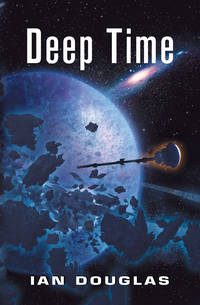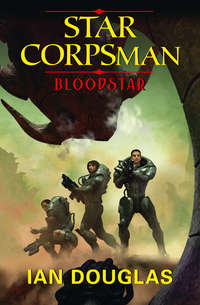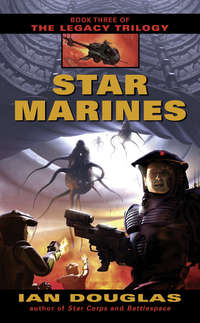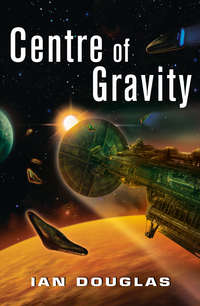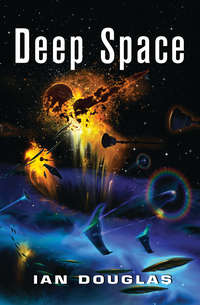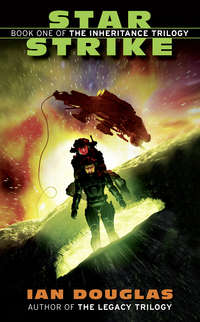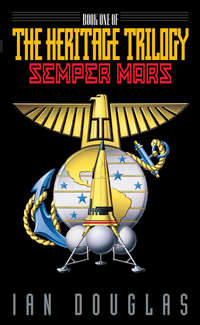
Полная версия
Singularity
A separate window opened in his mind as new data streamed into his implant. It showed America near the center of a scattering of ships, each tagged with name and hull number.
“It looks like they all did follow us,” Gray said.
“They did. We’re still missing eight ships. They’re probably still outside of our light-speed horizon, and we’ll see them in a few more minutes. Green are ships we know we can trust. Red are probably hostile. Amber are unknowns.”
The twenty-six ships of the original battlegroup were green, Gray noted. So too were twelve more ships—Abraham Lincoln’s battlegroup—which meant they were North American.
Twelve were red … the Pan-European contingent, minus eight stragglers. The remaining nine—the Chinese—were unknowns.
“Sir,” Gray said, “we’re not going to fight them, are we?”
“I don’t know, son. Possibly they don’t know either. They’re probably going to try to bluff us, and the old man is going to call them on it.”
It seemed like utter lunacy. The North Americans comfortably outnumbered the European warships, but an exchange of fire would cause a lot of damage on both sides, something the human fleet simply couldn’t afford this far from home. Damn it, the Sh’daar and the Turusch and the H’rulka were the enemies … not the damned Europeans!
“We expect the French carrier Jeanne d’Arc to attempt to close alongside of the America,” Wizewski continued. “The fighters are going to block her, because we can’t afford to let a ship with her firepower get close enough to fire a broadside. One hundred thousand kilometers. That’s the minimum stand-off distance. Understand?”
“I think so, sir. Are … are we authorized to fire?”
“Only on my command, or on the command of Admiral Koenig himself.”
“Yes, sir.”
“We’re going to try our damnedest to talk our way out of this. If we can’t …”
He left the thought unfinished.
“I understand, sir.”
On the tactical display, the Jeanne d’Arc and her consorts were still almost a full astronomical unit away, but they were on a convergent course, closing with the America. The American ships were positioning themselves in a tight globe around the carrier, with the heavy cruisers Valley Forge and Ma’at Mons, along with a number of frigates and destroyers squarely between the approaching French flotilla and the USNA carriers. The Ma’at Mons, particularly, was a heavy bombardment ship … but she’d expended a lot of her warload against the A1-01 orbital factory. Gray wondered if she had enough munitions on board to keep the Europeans at a healthy distance.
Civil war.
Gray had little use for the Terran Confederation. Hell, as a Prim living out on the USNA Periphery, in the ruins of Old Manhattan, he’d had little use for the United States of North America, either. So far as he could tell, the argument between them involved a difference of strategy. The Confederation wanted to talk with the Sh’daar, and perhaps accept terms, while Koenig wanted to draw the enemy off into deep space, away from Earth and her colonies. Gray didn’t understand how the two could be mutually exclusive, or how Koenig could get away with setting Confederation military policy.
If forced to choose between the two, though, Gray would go with Koenig, if only because he was doing what he thought was right, and to hell with the politicians and rear-echelon second-guessers in Geneva or in Columbus.
Koenig was a fighter, and that was enough for Trevor Gray.
CIC
TC/USNA CVS America
Kuiper Belt, HD 157950
98 light years from Earth
1358 hours, TFT
“Do you think they’ll fight, Admiral?” Captain Buchanan asked.
The voice spoke inside Koenig’s head, since America’s commanding officer was on the ship’s bridge, forward from the Combat Information Center, which was the central brain for the entire battlegroup. Koenig was looking down into the tactical display tank, where a cloud of green, amber, and red icons drifted toward a seemingly inevitable collision.
“I don’t know, Randy,” Koenig said. “I don’t know Giraurd. Can’t get a handle on him.”
He’d called up every bit of biographical data on Francois Giraurd that he could find in the Fleetnet database, but found little that was useful. Giraurd was only fifty years old, remarkably young for a grand admiral. Born in 2344, he’d been twenty-three, an engineering major at the Sorbonne, when the Sh’daar Ultimatum had come down through their Agletsch proxies. He’d entered the French Acádemie d’Astre as a midshipman cadet in 2368, the year of the disaster at Beta Pictoris, the opening round in the Sh’daar-Confederation War.
His first command had been the gunship Pégase in 2374, and on his promotion to capitaine de frégate five years later he’d been given the command of the De Grasse, serving with the Terran Confederation’s Pan-European contingent.
He’d never commanded a ship in battle, however, for either Pan-Europe or the Confederation. He’d made contre-amiral in 2389, at age 40, then vice-amiral in 2394, and vice-amiral d’escadre in 2397, a spectacularly swift rise up the hierarchy of flag rank. His final promotion to grand-amiral had been conferred in 2403. He’d been in command of a joint Franco-German-Russian fleet in Earth Synchorbit, Koenig noted, during the Defense of Earth, but that fleet had not seen combat.
An uncle of Giraurd’s had been the French prime minister from 2385 through 2397, which just might explain his lightning rise through the ranks. He also had a cousin, General Daubresse, currently on the Confederation Joint Chiefs of Staff, and the Giraurd family was one of the wealthiest in Pan-Europe. Family, political, and financial connections weren’t supposed to have any influence on promotions within the Confederation military, but everyone was all too aware of the reality. Both Pan-Europe and the UNSA had families who’d rotated between politics and the military going back for generations.
“I think he’s more bluff and bluster than anything else,” Buchanan said. “The real problem is going to be DuPont and the politicos back in Geneva. I’d like to know exactly what Giraurd’s orders are right now.”
Koenig had been thinking the same thing. Clearly, the Confederation government had hoped that Girard’s arrival would overawe Koenig enough that he would meekly return to Earth—coupled, carrot and stick, with the promise of being made president of the Confederation Senate.
“Admiral? This is fleet communications,” Lieutenant Julio Ramirez said, interrupting electronically.
“Excuse me, Randy. Go ahead, comm.”
“Incoming transmission from Jeanne d’Arc. Time lag … seven minutes, twenty seconds.”
“Very well.” Koenig opened the channel to include Buchanan. “Captain? You might want to listen in on this.”
“Of course, sir.”
A window opened in Koenig’s mind, static-blasted, then clearing. Giraurd’s face peered out at him. “Admiral Koenig, this is Grand Admiral Giraurd, on board the Confederation star carrier Jeanne d’Arc. I must inform you that I have the authority of the Terran Confederation Senate to place you under arrest if you do not comply with their orders.”
“He followed us for a hundred and fourteen light years to tell us that?” Buchanan asked.
“He probably can’t go back empty-handed,” Koenig replied, as Giraurd continued talking in the background. The transmission was strictly one-sided, a monologue. It would take another seven and a half minutes, nearly, for any response to get back to the approaching Jeanne d’Arc.
“My orders,” Giraurd was saying, “are to take command of CBG-18 and organize its immediate return to Earth. …”
“So what are we going to do about it?” Buchanan asked.
“What am I going to do about it,” Koenig replied. “No sense in your career getting fried too.”
“Admiral, we’re long past that point. If they hang you, they’re going to hang every senior officer in the battlegroup.”
Giraurd kept speaking. “You are hereby directed to shut down your maneuvering drive and your weapons systems and prepare to receive the Jeanne d’Arc alongside. I am awaiting your immediate reply. Giraurd, Jeanne d’Arc, out.”
“Well,” Koenig said. “Short and to the point.”
“We’re going to have to make a fight-or-flight decision in another … call it three hours, sir.”
“I know. Ramirez?”
“Yes, Admiral.”
“Can you patch through a high-focus laser on Illustrious?”
There was a brief delay. “Yes, sir. No problem. We have a clear shot. The time lag is … make it seven thirty-five.”
“Do so. I want Captain Harrison on the link, personal and private.”
“Aye, aye, Admiral.”
Koenig knew Captain Ronald Fitzhugh Harrison, the skipper of the British assault carrier Illustrious. If Giraurd was bluff and bluster, Harrison was the real deal. He was a veteran of a number of actions, including both Sturgis’s World and Everdawn against the Turusch; Cinco de Mayo, against EAS; and the Chinese Hegemony and Spanish rebels, and he included among his service medals both the Conspicuous Gallantry Cross and the Distinguished Service Cross.
“Jeanne d’Arc has tagged their transmission with an immediate response requested, Admiral.”
“Ignore them.”
“Aye, aye, sir.”
Koenig thought for a moment, then began recording his transmission to Harrison.
“Hello, Ron. This is Alex, on the America. I’m sure you’re under orders not to receive transmissions from us, but before you cut me off you’d better have a look at the attached intel. They might not have told you everything.
“If you’d care to chat, tag me back. Koenig, awaiting your reply. Out.”
He attached a file with the name “Operation Crown Arrow” and uploaded it to Fleet Communications. It would be on its way down a laser beam aimed at the Pan-European carrier Illustrious within seconds.
It would be more than fifteen minutes before he could expect a reply.
For almost four decades, since the Sh’daar Ultimatum, the Terran Confederation had been shrinking, its borders on several fronts relentlessly pushed back by the encroaching Sh’daar Alliance. They’d taken Rasalhague, forty-seven light years from Sol, in 2374. Twenty-three years later, they’d hit Sturgis’s World, at Zeta Herculis, thirty-five light years out.
And a few months ago, just before CBG-18 had left the Sol System, they’d taken the colony at Osiris, 70 Ophiuchi AII. That was just sixteen and a half light years away, practically on Earth’s doorstep, astronomically speaking.
The Sh’daar and their subject races were closing in.
Operation Crown Arrow had been devised to buy the Confederation time, a raid deep, deep into Sh’daar-controlled space, striking at fleet assembly points, manufactory centers, and staging areas. WHISPERS, the Weak Heterodyned Interstellar Signal Passband-Emission Radio Search, had detected a number of sources of faint, intelligently directed radio signals and identified them as probable sites of Sh’daar or Turusch activity. The immense manufactory at Alphekka, sucking in debris from the star’s protoplanetary disk and building Turusch warships, had been one of the loudest of these, but there was a list of more distant sites as well.
And with the capture of the Alphekkan manufactory had come the Alphekkan Directory, a Turusch list of other military bases within about five thousand light years of Sol.
That list proved one important thing. The Sh’daar and their Turusch proxies were stretched thin. It couldn’t really be otherwise, not in a galaxy of 400 billion stars. The enemy couldn’t maintain a guardian fleet within every star system. They couldn’t even put guards within every inhabited system.
Koenig was certain now that the Alphekkan base had been designed for nothing less than building a fleet intended to subjugate—possibly to destroy—Earth. A huge number of ships, empty and waiting, had been captured there. The Sh’daar might be planning on using the newly captured base at 70 Ophiuchi, but that was across 42 degrees of Earth’s sky, a straight-line distance of 62.5 light years from Alphekka. The almost overwhelming likelihood was that the enemy had hit 70 Ophiuchi as a diversion, to pull human fleet resources away from Sol. The main strike, Koenig thought, would come from the direction of the constellation of Corona Borealis, from Alphekka.
Operation Crown Arrow called for an initial strike at Alphekka in order to cripple the Sh’daar assets there … and that strike had been an unprecedented success. But the follow-on had called for CBG-18 to continue deeper into Sh’daar space, ideally drawing off the enemy forces now pressing so hard on Sol, getting them to follow America and her consorts.
Exhaustive analyses had gone into the planning. Step by step, Koenig, using a small army of artificial intelligences, had shown conclusively that running from point to point to meet individual Sh’daar advances—like the taking of Osiris—would inevitably leave Earth vulnerable to a final, overwhelming attack. The Confederation did not have the capacity in personnel, in equipment, or in industrial strength to meet the Sh’daar on anything like an equal basis long term.
That, Koenig, thought, should have been self-evident. According to the alien Agletsch, the Sh’daar dominated something like a third of the galaxy, which meant more than 100 billion suns, billions of habitable worlds, and an estimated 5 million technic civilizations. The Confederation had Sol and a handful of colonized star systems—twenty-five, at last count, plus a couple of hundred outposts and research stations. Twenty-five worlds against an unknown number of billions … a flea against some giant, enormous extinct beast, a tyrannosaur, a titanothere, or an elephant. It was impossible. …
But Koenig had an idea that might work. Alphekka had been a spectacular victory; now, CBG-18 needed to hit the next target, and the next one after that. The Alphekkan Directory had pointed him to a likely candidate, a star system not listed on any human catalogues, but known to the Agletsch as Texaghu Resch.
Hit that, and Koenig believed that every Sh’daar fleet within a thousand light years would be chasing him. After that …
“Admiral? Incoming … from Captain Harrison, on the Illustrious.”
Koenig checked his internal clock. What the hell? Only five minutes had passed since he’d sent the message to Harrison; he hadn’t even had time to receive it yet. This must be one of those “great minds” moments; Harrison had tried to reach him within moments of his trying to communicate with Harrison.
“Put it through. Randy? Listen in, please.”
Within his mind, a communications window opened, and Harrison’s face appeared. “Alex! This is Ron Harrison. Remember me? The academy speech, two years ago.”
Koenig remembered. The two of them had together addressed the 2403 graduating class at the Naval academy. It wasn’t the last time he’d seen the man, but it was the last time he’d had more than a few minutes to talk with him.
“What the hell is going down, Alex?” Harrison continued. “Giraurd is about to bust a gut. He’s calling you a traitor and worse, and he’s told us that he intends to attack your squadron if you don’t do exactly what he says.
“This mess is a put-up hatchet job, I’m certain of that. This isn’t the Senate speaking. It’s a small clique inside the Senate—the damned Conciliationists. They haven’t figured out yet that appeasement never works.
“Now, I notice the other USNA ships in our flotilla broke off and followed you. That was to be expected. Illustrious and two others, Warspite and Conqueror, are under my direct command … and I’ll be damned if I’m going to see them fire the opening shots of a civil war. Give the word, and I’ll slide the three of us over to your side of the line.
“Harrison, awaiting your reply. Out.”
“Well, well,” Buchanan said. “Division within the enemy’s ranks?”
“They’re not our enemies,” Koenig said.
He was thinking furiously. How well did he trust Harrison? Was this a genuine offer to change sides … or was it a covert move directed by Giraurd, an attempt to get three major warships in close to the America? Koenig hated the paranoid thought, but he had to consider every possibility.
What, he wondered, had been the speech at the academy? When the topic didn’t come immediately to mind, he downloaded it from his personal database. Koenig’s speech had been about the need to be vigilant and develop a unity of purpose and strategy in the war against the Sh’daar. Harrison’s speech had been titled “The Worm Within: Covert Penetration of the Enemy’s Infrastructure.” He’d been telling the graduating midshipmen that they needed to think outside the box, to think not only in terms of classical fleet strategies, but to use high-tech infiltration techniques to tap into alien command and control systems. Koenig had done exactly that three months before, when he’d deployed a small SEALs team to covertly breach and enter a giant H’rulka warship moving into the Sol System in order to establish contact with the beings inside.
And now, Koenig thought, Harrison was using the title as a warning. This was a covert attempt to get his forces in close to the America.
“Ramirez,” Koenig said. “Reply to Captain Harrison, personal and confidential. Message begins.
“Hey, Ron, you Limey bastard. Got your message, all of it.” He thought for a moment. Chances were good that Giraurd was tapped in to Illustrious’s comm suite and reading the mail. He decided not to mention his previous message, which Giraurd may or may not have seen.
“The thing about a civil war,” Koenig went on, “is that it is never civil. We can’t afford to bloody each other, and I refuse to become the bone of contention that splits open the Terran Confederation. The enemy is out there, not within our own ranks.
“I appreciate your offer, but for now, I’d prefer that Illustrious, Warspite, and Conqueror remain with the Pan-European fleet. We are establishing a no-cross line one hundred thousand kilometers from the America, and we ask that you respect that.
“I hope that when this is over, you and I can sit down in a wardroom, your ship or mine, and have a cold one and a good laugh about this. For now, please stay clear.
“Koenig, America, out.”
In the tactical tank, the two fleets continued to draw closer together.
Chapter Three
10 April 2405
VFA-44
Kuiper Belt, HD 157950
98 light years from Earth
1715 hours, TFT
“Things are about to go supercritical,” Gray said over the squadron tac channel. “Reconfigure to sperm mode.”
The SG-92 Starhawk’s outer hull consisted of a matrix of conventional metals and ceramics blended with nano-molecules controlled by an electrical field projected by his ship’s AI. Launch configuration was a slender needle with a swollen central area housing the cockpit, designed for magnetic acceleration down the launch tube. Combat configuration looked a bit like a headless bird with down-canted wings, providing widely separated weapons and sensor platforms useful in a fight.
Sperm mode was fighter-slang for high-velocity configuration—a blunt-nosed egg shape with a long, tapering tail. The old, conventional wisdom that said that spacecraft didn’t need to be streamlined in the vacuum of space broke down when the vessel could approach the speed of light. At those speeds every little bit helped.
Gray didn’t know what was going to happen in the next few moments, but he did know that their survival would depend upon their speed and their maneuverability.
The twelve Starhawks had been patrolling in combat mode, but now their wings began folding in toward their bodies, their black surfaces turning cold-molten and flowing like thick water. They were drifting along the no-cross line, an empty region of space defined by its distance, 100,000 kilometers, from the America.
The heavy cruiser Valley Forge was only five kilometers off his starboard side at the moment, three quarters of a kilometer long, a slender stem behind an outsized forward cap shaped like a flattened dome. To the naked eye, she appeared slightly blurred and indistinct. Shield technology involved bending space sharply above and around a ship’s hull, and that bending caused light to twist. When an incoming projectile or thermonuclear detonation struck the field projected across a warship’s outer hull, that spatial warping momentarily became much stronger, deflecting the threat. Gravitic shielding was costly in terms of energy, however, and was generally switched on only when combat was imminent. Koenig, clearly, was taking no chances; high-velocity kinetic rounds could come slamming out of the darkness with little to no warning at all, and all ships in the battlegroup were at the highest possible alert status.
According to the tactical display, Jeanne d’Arc and the eleven other capital ships of the Pan-European contingent were a scant half million kilometers away, drawing ever closer.
“Hey … Skipper?” It was Shay Ryan, on a private channel.
“Yeah?”
“I don’t like the idea of shooting at our own guys, y’know?”
“Neither do I, Lieutenant.”
“If we get shot up way out here, it’s going to make fighting the Sh’daar, or getting home, a hell of a lot harder.”
“The brass’ll figure something out,” he told her. “They know a lot more about what’s happening than we do.”
He wished he felt that confident, though. Koenig was a good officer and a brilliant strategist, Gray thought, but he shared with most fighter pilots a measure of distrust for the men and women who made the tough choices in the relative safety of the CIC. Sure, their lives were on the line if the capital ships came under attack, but they weren’t out here, crammed inside a gravfighter with nothing but speed, maneuverability, and skill between you and the enemy’s incoming rounds.
He found himself wondering just what the battlegroup could do if Giraurd tried to push things. A traditional shot across their bows? And what if they called the bluff and kept coming? He called up a battlespace view, imagery transmitted from one of the thousands of robotic drones now dispersed throughout this region of space, for a closer look at the enemy.
There she was … the Jeanne d’Arc, a light star carrier, perhaps three quarters of the mass of America. Like all Alcubierre Drive ships, she had the same general design—slender spine aft, large, flattened dome forward. The shield cap had been painted blue and white, a sharp contrast with the sandblasted gray-black of America’s prow. Her name and number appeared pristine, newly painted. According to the warbook, the Jeanne d’Arc didn’t have America’s twin launch tubes running through the center of the shield cap. Instead, she possessed a single high-energy particle cannon, which gave her a formidable long-range bombardment capability above and beyond the punch carried by her fighters.
A whale swimming with minnows, the Jeanne d’Arc was accompanied by a cloud of fighters, tiny blue motes moving in her shadow.
Gray didn’t immediately recognize the Pan-European fighters, and had to pull an ID up on his warbook: Franco-German KRG-17 Raschadler fighters. He felt himself relax slightly. The Raschadler was roughly equivalent to the USNA SG-55 War Eagle, a design about twenty years old. They didn’t have the delta-V of Starhawks, the endurance, or the warload capability, and they didn’t possess the Starhawk’s high-tech ability to change its configuration for launch, for high-velocity travel, or for combat. In head-to-head knife fights with the Pan-Europeans, the Dragonfire Starhawks would come out on top every time. The problem was that no one wanted such a confrontation in the first place, least of all, Gray was certain, Koenig.




